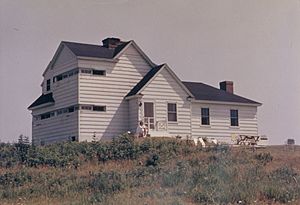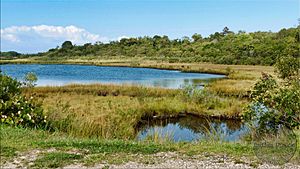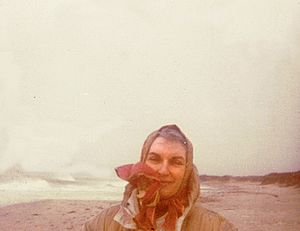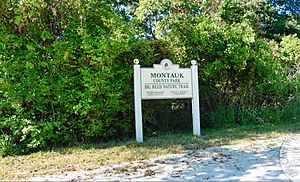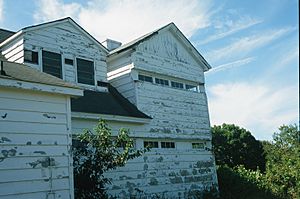Hilda Lindley House facts for kids
The Hilda Lindley House is a special building in Montauk, New York. It's named after Hilda Lindley, a brave woman who lived there and helped save a huge natural area called Indian Field from being covered in buildings in the 1970s. Sadly, even though she saved the land, her own house was taken from her by the government.
Contents
What is the Hilda Lindley House?
The Hilda Lindley House is located in the middle of Indian Field, a beautiful area with over 1,000 acres of hills, ponds, and grasslands. It sits at the very eastern tip of Long Island, looking out over Block Island Sound.
The U.S. Army built the house in 1944 during World War II. It was a secret "fire control station." Its job was to help spot enemy ships and planes along the coast. Even though it was made of strong concrete, it was designed to look like a simple cottage.
Hilda Lindley and her husband, Francis Vinton Lindley, bought the house in 1950 after the Army no longer needed it.
Hilda Lindley's Fight to Save Indian Field
In the 1970s, developers wanted to build many houses on Indian Field. Hilda Lindley knew how special this land was. She organized people to fight against the development. She started Montauk's first environmental group, called the Concerned Citizens of Montauk (CCOM).
Her efforts helped save a lot of Montauk's open spaces, even though there was a lot of pressure to build more homes.
In 1970, Hilda Lindley founded CCOM to protect Indian Field's unique nature and history. Developers planned to build up to 1,800 houses on the 1,000 acres. After a long and difficult fight, Hilda and CCOM convinced the Suffolk County government to buy much of Indian Field. This land became a park.
However, county officials decided to take Hilda Lindley's house and land using something called eminent domain. This means the government can take private property for public use, even if the owner doesn't want to sell it. Many people thought this was unfair and a way to get back at Hilda for stopping the development.
After several years of talks, Hilda Lindley and Suffolk County agreed that she and her family could stay in the house for 35 years. Hilda Lindley passed away in 1980, but her children and their families continued to live there. In 2010, the county ordered the family to leave the house.
The History of Indian Field
Indian Field was the last home of the Montaukett Native Americans. Their lands in Montauk were slowly taken over by European settlers, mostly English, starting in the late 1640s. The Montauketts believed they were selling the right to hunt, not giving up ownership of the land forever.
Despite some resistance, the English colonists kept expanding their control. In 1702, the Montauketts made an agreement with the Town of East Hampton. They were promised payments and could still "plant and improve" Indian Field. Montauketts lived, hunted, and gathered in Indian Field until the late 1800s.
In 1879, a businessman named Arthur Benson bought most of Montauk, including Indian Field. He wanted to build fancy homes for his rich friends. He also hoped to extend the Long Island Railroad to Montauk to create a major shipping hub. This plan never happened.
The sale of the land was "subject to the rights and privileges of the Montauk Tribe of Indians." Benson tried to get the remaining Montauketts in Indian Field to move to East Hampton. They were often tricked with false promises. They signed agreements to move their homes in exchange for a small amount of money.
Other Montauketts who had moved away were upset. They started legal and political efforts to get Indian Field back. These efforts continued until 1924 but were not successful.
The House as a Military Station
The U.S. Army Corps of Engineers finished building the Hilda Lindley House in the spring of 1944. It was one of ten fire control stations built in Montauk during World War II. These stations were built all along the U.S. coast.
The main goal of these stations was to look for enemy ships. If a ship or plane was seen, soldiers would figure out its exact location and direction. They would then send this information to nearby big guns, which would fire at the enemy.
Some fire control stations, like the Hilda Lindley House, were disguised as cottages. Others were simple dugouts or towers. One on Gardiner's Island even looked like a windmill to fool German sailors. Soldiers from the United States Army Coast Artillery Corps worked at these stations.
The Hilda Lindley House and other stations in Montauk protected an important shipping route to New York and southern New England. These Army lookouts had special instruments. They were the "eyes" for the large guns at Camp Hero State Park, near the Montauk Point Light.
After World War II, coastal defense changed. Radar stations took over the job of spotting threats. New weapons like cruise missiles and atomic bombs also made the old fire control system outdated.
The Hilda Lindley House cost about $22,000 to build. It was a two-story building on a hill, about 87 feet above the water. It had instrument rooms where soldiers used telescopes to look for enemy ships. They looked through narrow, slot-like windows.
The ground floor also had a kitchen, a dining area, a bathroom, and barracks with bunk beds for the soldiers. Coal-fed heaters provided warmth, and a gasoline generator supplied electricity. Soldiers climbed to the second floor using iron rungs.
The Lindley Family's Life in the House
After World War II ended, the Army left the Hilda Lindley House. It eventually became owned by the Montauk Beach Company. Hilda and Francis Lindley bought the house and two acres for $5,000 in 1950. The house was in poor condition, filled with trash from people who had broken in.
The Lindleys cleaned up the house. They added bedrooms and a bathroom in the attic and replaced the iron rungs with a staircase. However, the house kept its unique Army design, including the narrow slot windows used for spotting enemies.
Today, iron rungs still lead to a "crow's nest" inside the house. This was once disguised as a fake brick chimney on the roof. The house was remote, reached only by a dirt road. It relied on a generator for electricity to pump water from a well built by the Army. The Lindleys used kerosene lamps and candles for light. They used propane gas for their stove, refrigerator, and water heater. They heated the house with Army space heaters and wood-burning stoves.
Hilda and Francis Lindley divorced in 1956. Hilda continued to live in the house part-time, working in New York City to support her three children. The family kept the house in good condition. Hilda added a bigger kitchen and a deck in the late 1960s.
The Fight to Save the House
In 1970, a plan was proposed to build up to 1,800 houses in Indian Field. This plan also included cutting a new channel through Little Reed Pond to connect it to Lake Montauk. This would have changed the water and nature of Big Reed Pond, which later became a National Natural Landmark.
Hilda Lindley used newspaper ads and public meetings to gather support. She formed the CCOM, which became a leading environmental group. They asked government officials to buy the land to protect its open space, nature, history, and clean groundwater.
The U.S. government and New York State refused to buy Indian Field. But in 1971, Suffolk County Executive John V.N. Klein approved the county's purchase of Indian Field for parkland.
The purchase took time due to political issues. Finally, in November 1973, the county approved buying about 900 acres in Indian Field. It was first named Indian Field County Park, then Montauk County Park, and later Theodore Roosevelt County Park.
Even though Hilda Lindley led the effort to save Indian Field, Suffolk County ordered her to give up her house. This demand came from the Suffolk County Legislature. Many saw this as an act of revenge because Hilda had challenged powerful business and political groups.
Hilda Lindley continued to fight her eviction. She used lawyers and the press. She received support from famous people like aviator Charles A. Lindbergh. After long negotiations, an agreement was reached in February 1976. Hilda and her family could stay in the house for 35 years. After that, it would go to the county without payment.
Hilda Lindley passed away in 1980. Her family continued to live in the house, taking care of it and helping lost hikers in the park.
In August 2010, the Suffolk County Parks Commissioner ordered the Lindley family to leave the house by February 2011. County employees then changed the lock on the gate, preventing the family from entering.
What Happened Recently?
The East Hampton Press newspaper suggested in 2010 that Suffolk County should let the Lindleys stay for 10 more years. Later, a county legislator proposed that the house be officially named the Hilda Lindley House, and this was approved in December 2010. In February 2011, a local committee also asked the county to let the Lindleys stay.
However, the Suffolk County parks department let the house fall into disrepair. In February 2014, a county legislator introduced a bill to make the parks department create a plan for the house. This bill became law.
As of February 2015, the Lindley family's offers to renew their lease or help care for the house had not been accepted. The house remained empty and uncared for, with peeling paint and broken windows. County officials had done little to fix the damage or protect the house, despite pleas from the Lindleys and the community.
|


